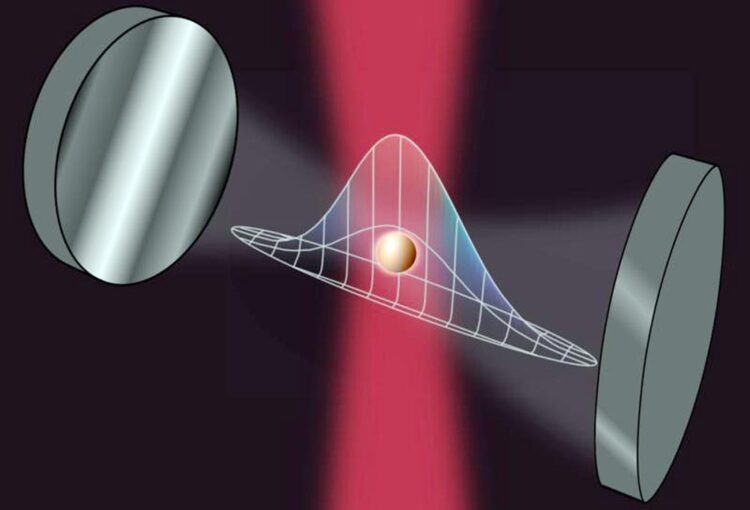Microcavities as a sensor platform

Nano particles trapped between mirrors might be a promising platform for quantum sensors.
(c) IQOQI Innsbruck
Sensors are a pillar of the Internet of Things, providing the data to control all sorts of objects. Here, precision is essential, and this is where quantum technologies could make a difference. Researchers in Innsbruck and Zurich are now demonstrating how nanoparticles in tiny optical resonators can be transferred into quantum regime and used as high-precision sensors.
Advances in quantum physics offer new opportunities to significantly improve the precision of sensors and thus enable new technologies. A team led by Oriol Romero-Isart of the Institute of Quantum Optics and Quantum Information at the Austrian Academy of Sciences and the Department of Theoretical Physics at the University of Innsbruck and a team lead by Romain Quidant of ETH Zurich are now proposing a new concept for a high-precision quantum sensor. The researchers suggest that the motional fluctuations of a nanoparticle trapped in a microscopic optical resonator could be reduced significantly below the zero-point motion, by exploiting the fast unstable dynamics of the system.
Particle caught between mirrors
Mechanical quantum squeezing reduces the uncertainty of motional fluctuations below the zero-point motion, and it has been experimentally demonstrated in the past with micromechanical resonators in the quantum regime. The researchers now propose a novel approach, especially tailored to levitated mechanical systems. “We demonstrate that a properly designed optical cavity can be used to rapidly and strongly squeeze the motion of a levitated nanoparticle,” says Katja Kustura of Oriol Romero-Isart’s team in Innsbruck. In an optical resonator, light is reflected between mirrors and it interacts with the levitated nanoparticle. Such interaction can give rise to dynamical instabilities, which are often considered undesirable. The researchers now show how they can instead be used as a resource. “In the present work, we show how, by properly controlling these instabilities, the resulting unstable dynamics of a mechanical oscillator inside an optical cavity leads to mechanical squeezing,” Kustura says. The new protocol is robust in the presence of dissipation, making it particularly feasible in levitated optomechanics. In the paper, published in the journal Physical Review Letters, the researchers apply this approach to a silica nanoparticle coupled to a microcavity via coherent scattering. “This example shows that we can squeeze the particle by orders of magnitude below the zero-point motion, even if starting from an initial thermal state,” Oriol Romero-Isart is pleased to say.
The work provides a new use of optical cavities as mechanical quantum squeezers, and it suggests a viable new route in levitated optomechanics beyond the quantum ground state cooling. Micro-resonators thus offer an interesting new platform for the design of quantum sensors, which could be used, for example, in satellite missions, self-driving cars, and in seismology. The research in Innsbruck and Zurich was financially supported by the European Union.
Wissenschaftliche Ansprechpartner:
Katja Kustura
Institute for Quantum Optics and Quantum Information
Austrian Academy of Sciences
P +43 512 507 52293
E katja.kustura@oeaw.ac.at
W https://romeroisartgroup.com/
Originalpublikation:
Publication: Mechanical squeezing via unstable dynamics in a microcavity. Katja Kustura, Carlos Gonzalez-Ballestero, Andrés de los Ríos Sommer, Nadine Meyer, Romain Quidant, Oriol Romero-Isart. Phys. Rev. Lett. 128, 143601 doi: 10.1103/PhysRevLett.128.143601
https://journals.aps.org/prl/abstract/10.1103/PhysRevLett.128.143601
[https://arxiv.org/abs/2112.01144]
Media Contact
All latest news from the category: Information Technology
Here you can find a summary of innovations in the fields of information and data processing and up-to-date developments on IT equipment and hardware.
This area covers topics such as IT services, IT architectures, IT management and telecommunications.
Newest articles

A new look at the consequences of light pollution
GAME 2024 begins its experiments in eight countries. Can artificial light at night harm marine algae and impair their important functions for coastal ecosystems? This year’s project of the training…

Silicon Carbide Innovation Alliance to drive industrial-scale semiconductor work
Known for its ability to withstand extreme environments and high voltages, silicon carbide (SiC) is a semiconducting material made up of silicon and carbon atoms arranged into crystals that is…

New SPECT/CT technique shows impressive biomarker identification
…offers increased access for prostate cancer patients. A novel SPECT/CT acquisition method can accurately detect radiopharmaceutical biodistribution in a convenient manner for prostate cancer patients, opening the door for more…





















